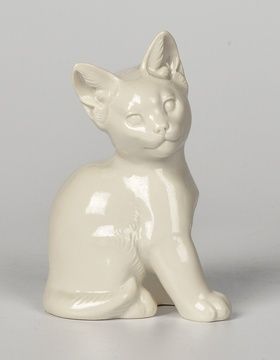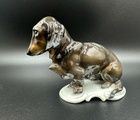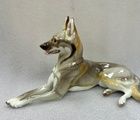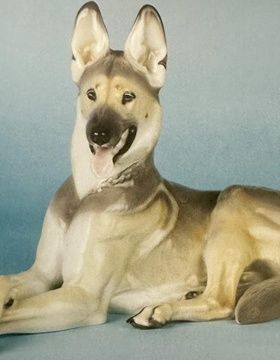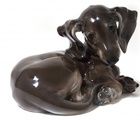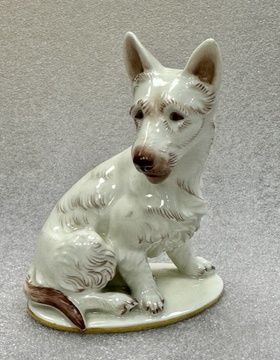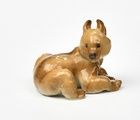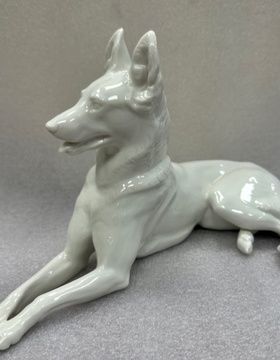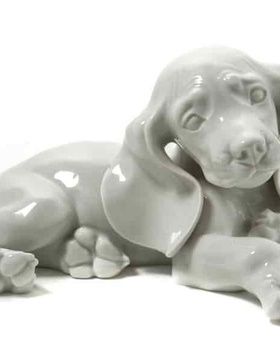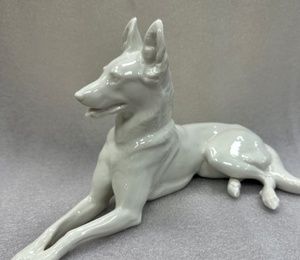Теодор Кернер спустя 20 лет
Теодор Кернер спустя 20 лет
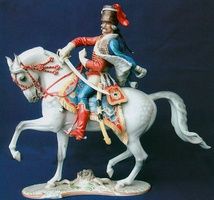
1935 – 1945
Спустя почти 20 лет, в возрасте 69 лет Кернер вновь будет делать модели для фабрики Розенталь и снова как внештатный сотрудник. Начиная с 1953 года скульптор сделал для неё 28 моделей и, если подсчитать все произведения в целом для фабрики, их число составит более 100.
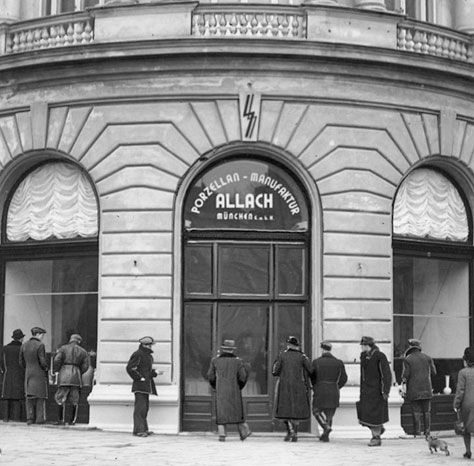 Магазин Allach в Варшаве, гостиница «Европейская» Магазин Allach в Варшаве, гостиница «Европейская» | 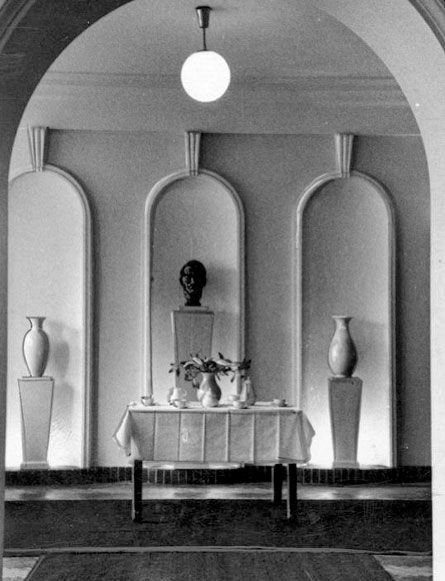 Магазин Allach во Львове, июнь 1942 Магазин Allach во Львове, июнь 1942 |
Следующую главу в биографии Теодора Кернера можно было бы назвать Porzellan Manufaktur Allach. Во всяком случае так первоначально называлась небольшая фабрика в предместьях Мюнхена. Allach—Untermenzing, одна из старейших общин Германии, была включена в состав Мюнхена в 1938 году. Фарфоровому заводу, который теперь известен как SS Porzellan Manufaktur Allach предшествовало частное предприятие, основанное Францем Надем (Franz Nagy), Карлом Дибичем (Carl Diebitsch) и Теодором Кернером. Об этом достаточно написано в биографии Франца Надя, одного из основателей фабрики и в материале «История возникновения и идеология». Последующее поглощение фабрики аппаратом СС и переход под контроль Главного административно-хозяйственного Управления СС произошёл в 1936 году, и инициатором процесса вероятнее всего был Карл Дибич, доверенное лицо и личный друг Генриха Гиммлера (Heinrich Himmler). Частная прежде фабрика стала обществом с ограниченной ответственностью (GmbH). Как следствие этого – дом и земельный участок, ранее принадлежавший Францу Надю перешёл также в собственность фабрики, считай в собственность СС.
К 1939 году фабрика расширилась и «разделилась» – фарфоровое отделение находилось начиная с этого времени на территории лагеря СС в Дахау, а керамическое отделение оставалось в München-Allach; Франц Надь работал там и как скульптор и как специалист в области технологий. И Аллах и Дахау, где были обе фабрики Allach, находились рядом с железнодорожными станциями. Это было важно, так как по железной дороге поcтавлялся тот самый каолин (белая глина) – необходимое сырьё для производства фарфора. Использующийся исключительно мануфактурой Allach, он поставлялся из месторождений в Zettlitz (Sedlec) около Карлсбада. В 1937 году открылось первое выставочное помещение фабрики в Берлине. Другие выставочные залы были открыты с началом войны в Познани, Варшаве и Львове. Любопытно, что в Мюнхене не было ни одного выставочного зала или офиса продаж фабрики.
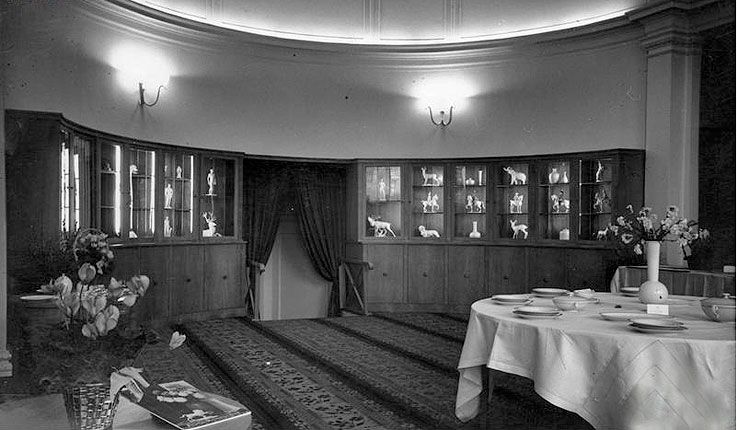
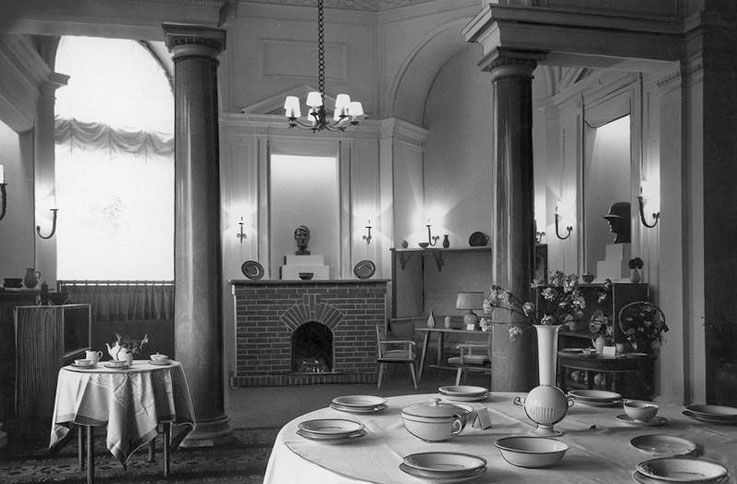
По правде говоря, даже по сравнению с фабрикой Нимфенбурга, объёмы выпускавшихся предметов художественного фарфора и керамики были настолько малы, что фабрика Allach была практически неизвестна широким слоям населения. Плюс ещё один важный момент, влиявший на «популярность марки» – изделия Allach принципиально никогда не поставлялись в «обычные» фарфоровые магазины.
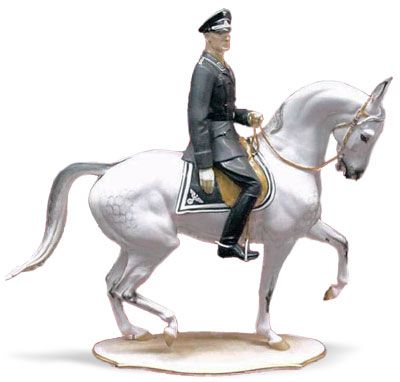 Я возьму на себя смелость предположить (пока нет никаких документов, утверждающих обратное), что появление Кернера в качестве главного скульптора Allach напрямую связано с его моделью конной фигуры офицера СС, выпущенной в конце 1934 года на фабрике Розенталя под номером 1549, а затем ставшей первой в модельном ряду мануфактуры Allach. В литературе, посвященной фабрике есть упоминая о том, что велись переговоры с Розенталем о производстве в больших объёмах спецзаказов для Гиммлера с привлечением скульпторов фабрики, но они были безрезультатными. Есть только одна модель, фактически указывающая на то, что такие переговоры действительно были. Скульптура конной фигуры офицера СС была последней из модельного ряда произведённых Розенталем фигур в 1934 году, а уже буквально через несколько месяцев начала работать фабрика в Аллахе и в первом её прейскуранте эта фигура появилась под номером «0».
Я возьму на себя смелость предположить (пока нет никаких документов, утверждающих обратное), что появление Кернера в качестве главного скульптора Allach напрямую связано с его моделью конной фигуры офицера СС, выпущенной в конце 1934 года на фабрике Розенталя под номером 1549, а затем ставшей первой в модельном ряду мануфактуры Allach. В литературе, посвященной фабрике есть упоминая о том, что велись переговоры с Розенталем о производстве в больших объёмах спецзаказов для Гиммлера с привлечением скульпторов фабрики, но они были безрезультатными. Есть только одна модель, фактически указывающая на то, что такие переговоры действительно были. Скульптура конной фигуры офицера СС была последней из модельного ряда произведённых Розенталем фигур в 1934 году, а уже буквально через несколько месяцев начала работать фабрика в Аллахе и в первом её прейскуранте эта фигура появилась под номером «0».
Возможно, что именно она явилась «экзаменационной пробой» для Кернера и вообще для будущей фабрики. Не случаен также и тот факт, что почти все скульпторы, так или иначе принимавшие участие в «проекте Allach», ранее работали на фабрике Розенталь. Теодор Кернер, не являясь штатным сотрудником Розенталя и, соответственно, не связанный с фабрикой контрактными обязательствами легко мог принять предложение возглавить новую фарфоровую фабрику, тем более, что такой значимой должности до того времени у него не было. Кернеру 51 год, на фабрике Allach он и главный скульптор и художественный руководитель – полная свобода для творчества и, что немаловажно, практически без слишком жёстких сроков работы над моделями, по крайней мере в первые годы существования фабрики, главное результат. Вот простой пример: две очень похожие модели – сидящий щенок таксы. И опять, не случайно, но вероятно из желания довести работу до совершенного образца, Кернер на основе своей «розенталевской» модели 1933 года (номер 1247) делает новую скульптуру для фабрики Allach (модель номер 2). Несомненно, такса Розенталя во всём хороша, но такса Allach просто великолепна.
![Cлева – щенок таксы № 2 [ALLACH]; справа – щенок таксы № 1247 [ROSENTHAL]](/public/media/st/002/Junger-Dackel_2.jpg)
Вот несколько наиболее известных скульптур Теодора Кернера, выпущенные фабрикой в первые годы своей работы.
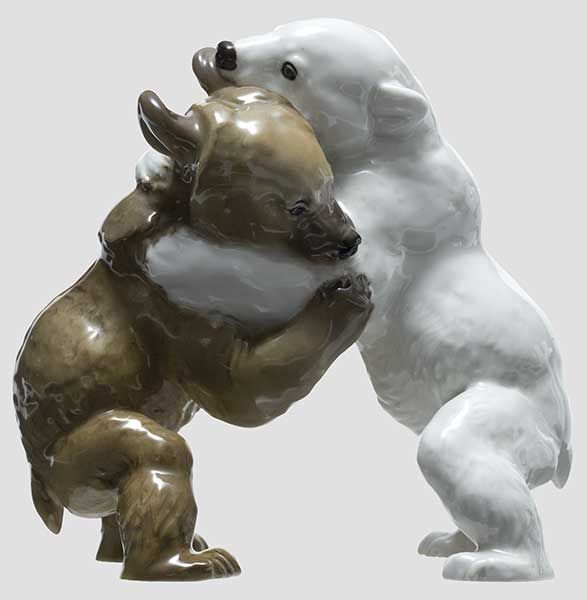 | 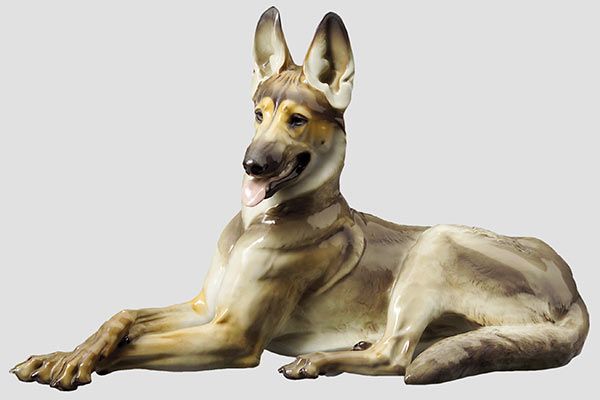 | 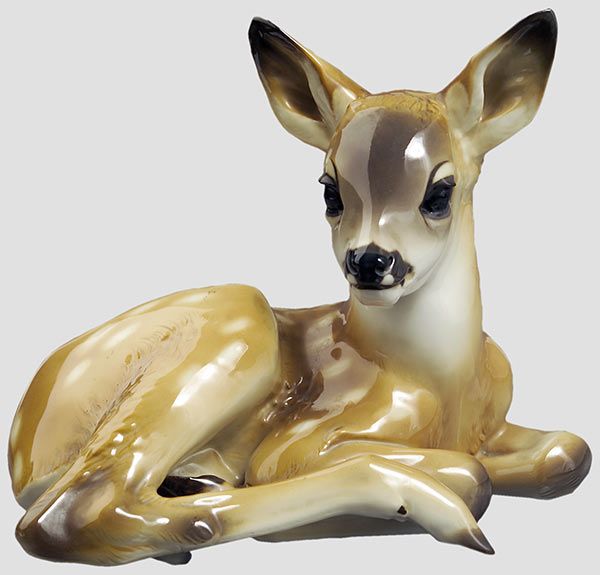 |  |  | 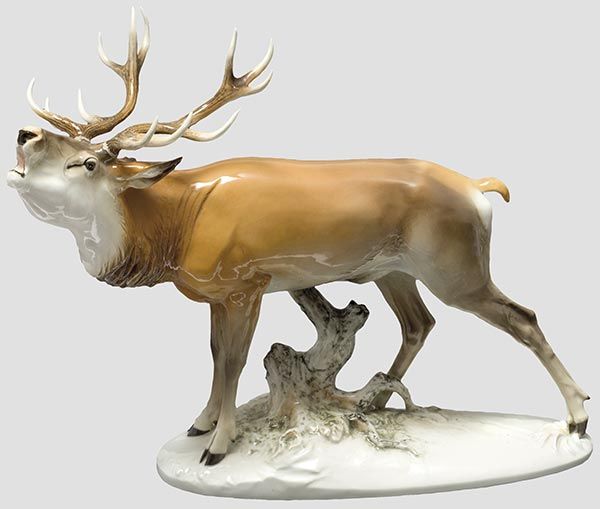 |
За исключением предметов, которые выпускались как государственные подарки или городские заказы, изделия фабрики можно было купить очень недорого в специально оборудованных выставочных помещениях. Фарфор Allach был явно самым дешёвым из всего выпускавшегося в Германии тех лет. О том, что это не пустое утверждение говорит следующий пример. В 1914 году Теодор Кернер выполнил модель лежащей лисицы (номер 481) для фабрики Нимфенбург. Речь идет, без сомнения, об одной из лучших скульптур, которую он для неё создал. Согласно прейскуранту фигура стоила в белом варианте 21 и в цветном 42 золотые марки. В прейскуранте Allach можно найти похожую модель (номер 79), которая в белом варианте стоила 3,92 и в цветном исполнении 6,25 рейхсмарок – и это цена при ежемесячной минимальной зарплате квалифицированного рабочего в 150, а среднего врача в 500 рейхсмарок в 1938 году.
![Cлева – Крадущаяся лиса № 79 [ALLACH]; справа – лежащая лиса № 481 [Нимфенбург]](/public/media/st/002/fox-79allach-nymf.jpg)
При обзоре моделей Porzellan-Manufaktur Allach-München GmbH обращает на себя внимание тот факт, что, например, подсвечники, фигуры в национальных костюмах, солдаты или танцоры-морискены – выпущены как серия одного из скульпторов мануфактуры. Наряду с многочисленными фигурами животных, фигуры лошадей красной нитью проходят через всё творчество Кернера. В этой связи я особо хотел бы остановиться на фигурах всадников. В ежемесячном отчёте фабрики по планированию за декабрь 1941 года есть запись о том, что «профессор Кернер работает над завершением серии всадников; Фёстер работает над серией пехотинцев». Вот что писал ежемесячник «Мюнхенская мозаика» в 1938 году о Кернере: «Если речь идет об исторических группах, то он (Kärner) основательно занимается сначала изучением костюмов и исторических источников, относящихся к предмету, делает карандашные эскизы, а затем твёрдой рукой моделирует коня и всадника. Они – его любимцы».
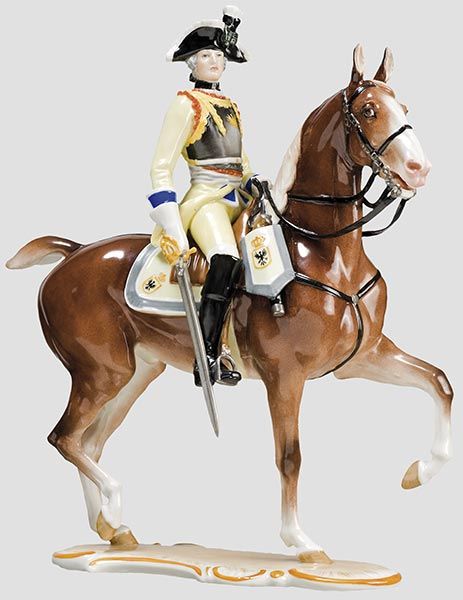 Seydlitz-Kürassier, модель №17, Allach Seydlitz-Kürassier, модель №17, Allach | 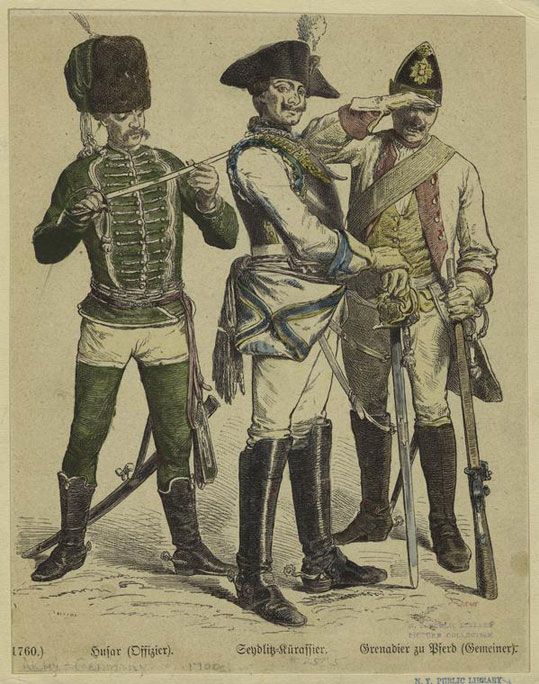 Seydlitz-Kürassier 1760, гравюра 1913 г. Seydlitz-Kürassier 1760, гравюра 1913 г. |
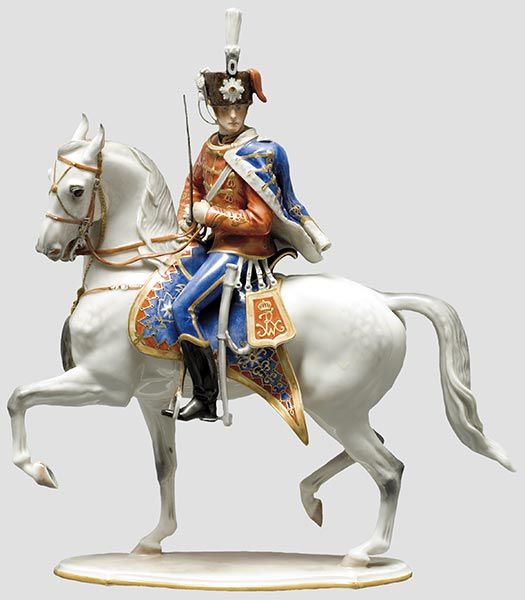 Гусар гвардии, мод. № 93, Allach Гусар гвардии, мод. № 93, Allach | 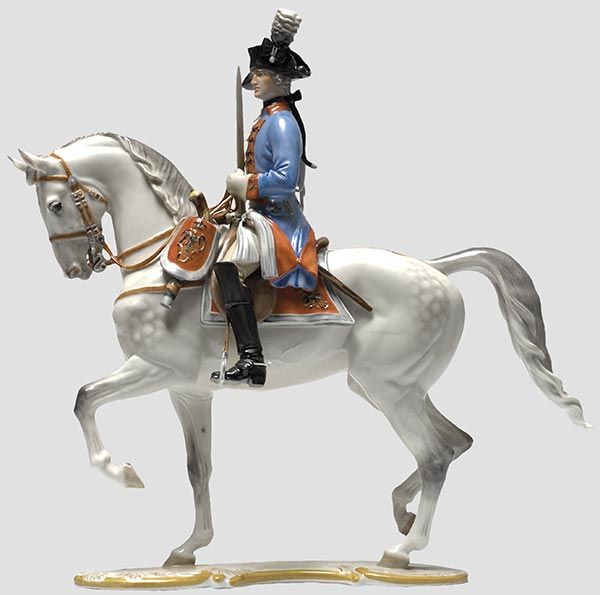 Драгун, модель № 97, Allach Драгун, модель № 97, Allach |
C 1936 года до начала войны в 1939 году Кернер создал для PMA более 43 моделей. Среди них «Зейдлиц-Кирассир» (Seydlitz-Kürassier, модель № 17), «Офицер-гусар гвардии» (модель № 29), «Амазонка» (модель № 82), «Гусар гвардии» (модель № 93), а также «Фридрих Великий» (модель № 94). Замечу, что в «Предварительном прейскуранте и модельном каталоге» (Прейскуранты«А» и «B»), а также в «Прейскуранте II», модель номер 29 ошибочно приписывается Францу Надю. Ошибка была исправлена позже, в каталоге 1938/39 года, который проверялся, наверное, более критически и более подробно, чем гектографические списки, частично написанные с помощью пишущей машинки. В том же каталоге «Амазонка» отмечена ещё и в ряду трёх фигур sonderanfertigungen (индивидуального дизайна) вместе с «Афиной» и «Мюнхенским ребёнком», как почётный дар в соревнованиях по конному спорту «Braune Band». После соревнований фигура производилась для продажи.
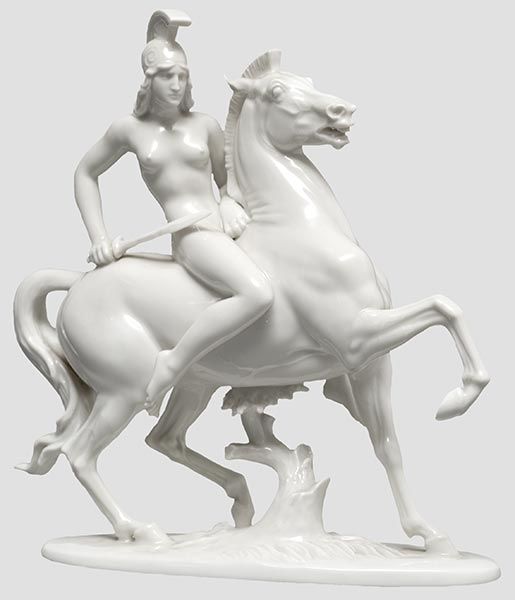 Амазонка, модель № 82, Allach Амазонка, модель № 82, Allach |  Офицер-гусар гвардии, модель № 29, Allach |
Если более подробно останавливаться на заказах от муниципальных властей на изготовление фигур, то в этой связи нужно отметить письмо Кернера директору Управления культуры города Мюнхена Рейнхарду, в котором от пишет: «Возвращаясь к нашей недавней беседе, я хотел бы сообщать Вам, что, к сожалению, не имею возможности закончить модель Гусара к сроку, так как я перегружен различными срочными работами». Речь в письме идёт о модели «Гусара гвардии», номер 93. Возможно, о сроках была устная договорённость между Кернером и Рейнхардом. 20 мая 1938 года Kärner писал обер-бургомистру города Мюнхена: «В настоящее время модель стоит в пластилине у меня в ателье. Она должна будет быть отлита в гипсе, на что потребуется ещё довольно много времени». Наконец, 21 сентября 1938 фигура была завершена. Прошло ещё довольно значительное время, пока она была выпущена фабрикой серийно. Фигура не попала в каталог 38/39 года, но «Гусар гвардии» в приложении к отчёту о состоянии дел к 31 декабря 1939 года указан как исполненный в количестве 21 модели в белом варианте и в 8-ми цветных моделях. До начала войны фабрикой Allach была выпущена модель номер 94 «Фридрих Великий» («Старый Фриц») в 32-х белых и 4-х цветных экземплярах, а также модель номер 97 «Драгун» в 13 белых и 2-х цветных экземплярах.
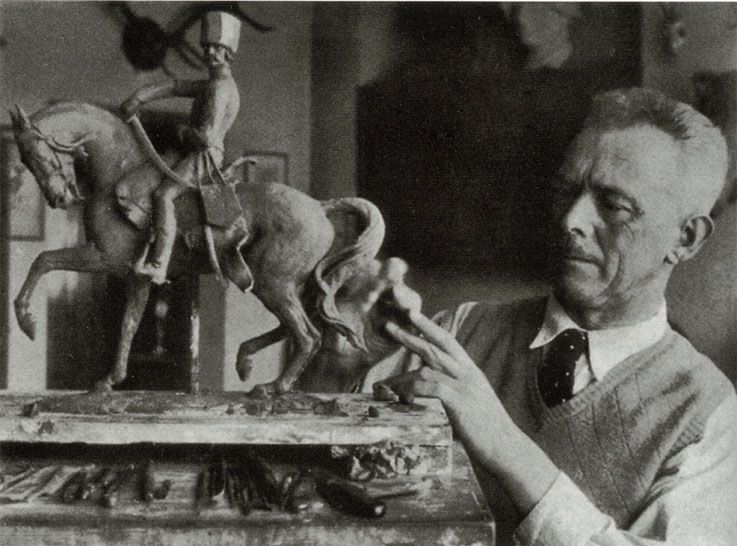
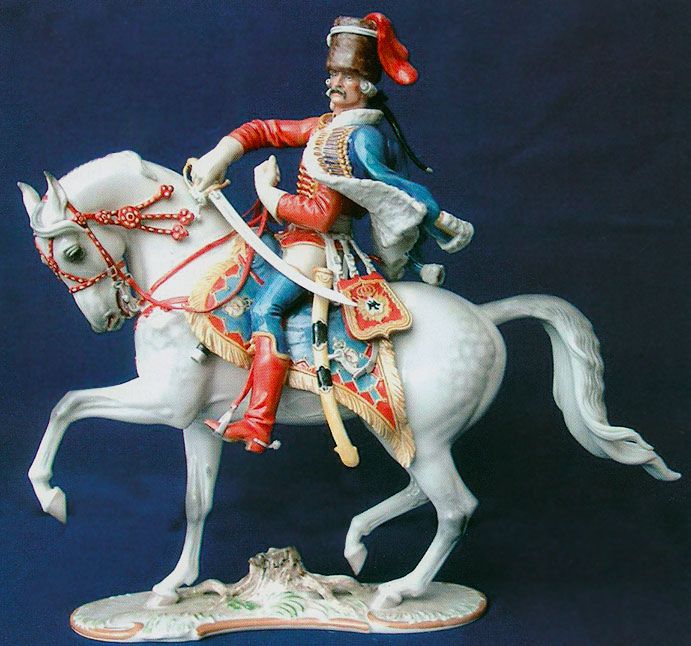 Ziethen-Husar 1765, Allach Ziethen-Husar 1765, Allach | 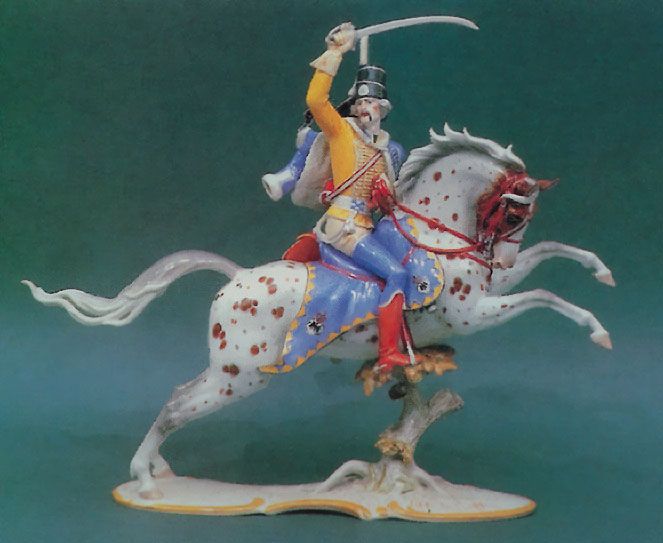 Malachowski Husar, Allach |
Во время войны на фабрике выходят: модель номер 115 «Zieten-Husar 1756», модель номер 121 «Malachowski Husar», а также модель номер 163 «Жандарм верхом на лошади», которая обозначалась также как «Полицейский жандармерии», изображения которого нет до сих пор. «Zieten-Husar 1756», а также до сих пор не подтвержденный «Panduhr» обозначены Кернером в месячном отчете на декабрь 1941 года как «находящиеся в планировании». Управляющий PMA Дахау Рудольф Дипп (Rudolf Dippe) 20 декабря 1943 года сообщает в личный штаб рейхсфюрера СС: «В качестве ещё одного специального изготовления для рейхсфюрера-SS была создана модель «Офицер жандармерии». Модель в соответствии с письмом подполковника CC доктора Брандта от 30.11.(1943)…выполнена. Мы просим Вас, чтобы Вы выдали нам заказ для этой модели». Спустя три месяца, 3 марта 1944 года, Дипп пишет следущее: «Что касается конных скульптур, к сожалению, производственная ситуация в начале этого года сложилась катастрофическая. Единственный ещё имеющийся в распоряжении специалист серьёзно болен и едва ли сможет появляться на заводе более чем один раз в месяц». 24 марта1944 года Дипп написал фроляйн Лоренц (Lorenz), адъютанту рейхсфюрера-СС, которая отвечала за подарочный фонд: «Скульптура всадника, к сожалению, – как было объявлено ранее, отменяется, так как единственный специалист, которому могут доверить эту работу, заболел и, вероятно, до середины этого года не сможет работать». 17 апреля 1944 года Рудольф Дипп сообщает в личный штаб рейхсфюрера СС: «После того, как за последнее время от рейхсфюрера СС поступило снова несколько заказов на фигуры всадников, мы хотели бы обратить Ваше внимание ещё раз на то, что в настоящий момент изготовление всадников невозможно. Единственный специалист, который может выполнять эти сложные работы, болен уже довольно продолжительное время; вероятно, только в июне или в июле, если позволит ему здоровье, он сможет приступить к работе. Другие рабочие руки, принимающиеся в расчёт, когда ведутся такие работы, призваны на фронт; между тем один специалист умер. Поэтому мы хотели бы просить Вас, чтобы Вы ставили в известность рейхсфюрера, что только лишь незначительный складской запас фигур имеется в наличии, которого должно хватить до конца августа. Ниже прилагается список конных скульптур, имеющихся на складе.
- В цвете:
- 2 Seydlitz-Kurassier,
- 2 Фридриха Великого,
- 1 Гусар гвардии,
- 1 Гусар Zieten,
- 4 Гусара Malachowski,
- 1 Драгун,
- 3 Всадника SS.
- Белые:
- 4 Гусара гвардии,
- 1 Гусар Malachowski,
- 3 Полицейских жандармерии,
- 4 Всадника SS.».
Катастрофическое положение в производстве 1944-45 года на фабрике способствовало привлечению к работе заключённых концлагеря «Дахау», а некоторым узникам спасала жизнь. Арестант концентрационного лагеря, Ханс Ландауер вспоминает: «После смерти Адольфа Зауера, главного модельщика мануфактуры, мастер Гайн рекомендовал меня для работы над фигурами «Старый Фриц», «Гусар Ziethen» и «Pandur». Для этих фигур, которые состоят из нескольких дюжин отдельных частей, нужно было ещё добавить поводья ручной работы и стремена, которые делались из смеси гуммиарабика с фарфоровой массой…. Благодаря моей работе, я был необходим для фарфорового завода. Тем более, что мастер Гайн заболел воспалением лёгких и тоже внезапно умер». Далее Ханс Ландауер пишет: «Когда я стал уже делать всадников, он (профессор Кернер) приехал однажды с Йозефом Тораком и я рассказал ему, что недавно закончил фигуру «Старого Фрица».
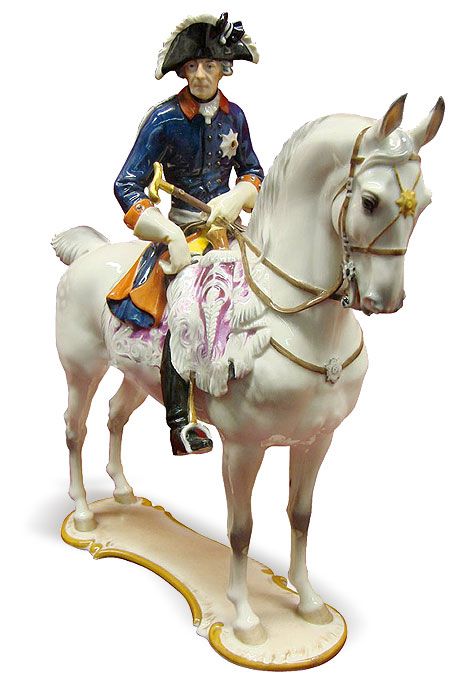
В качестве художественного руководителя мануфактуры Теодору Кернеру удалось собрать из внештатных сотрудников «замечательную команду» высококлассных скульпторов. Среди них Вильгельм Нойхаузер и Карл Химмельштос, профессор Вильгельм Кригер, Оттомар Обермайер и профессор Вилли Зюгель. Все они были знакомы с Кернером по работе или на Нимфенбурге или на фабрике Розенталя. Если доверять слухам об исключительно нацистской идеологии фабрики, которые распространяются с давних пор о фарфоре Allach, можно было бы опорочить всех упомянутых художников только потому, что они несколько лет проработали на фабрике. Необходимо осмыслить и тот факт, что Теодор Кернер, абсолютно неполитический художник, в 1945 году был арестован оккупационными властями и помещён в лагерь для интернированных Moosburg, политическую тюрьму, в которой провёл два года. Теодор Кернер состоял в довольно невысоком чине SS-Hauptsturmführers (хаупт-штурмфюрер = капитан). 9 ноября 1936 года он получил, вернее принял его потому, что не смог бы отказаться без определённых для себя последствий. Для сравнения, представьте на секунду такой аналог из недавнего прошлого нашей страны – может ли, например, директор завода не быть членом КПСС?
А учитывая упорно прививаемый после 1945 года немцам «комплекс вины», именно поэтому его имя не упоминается в ряду выдающихся скульпторов Германии. Тоже самое было до недавнего времени с вышеупомянутыми внештатными скульпторами фабрики Allach. Сложился даже такой стереотип «работал на Allach = служил в СС». Но вот что интересно и это прямо-таки причудливо, если вспомнить, что непосредственно сразу после окончания войны в сфере торговли произведениями искусства в США и Англии, произведения политически объявленого в Германии вне закона художника Теодора Кернера достигали необычайно высоких цен, отнюдь не таких, какие были установлены когда-то в Allach.
Не говоря уже о сегодняшних ценах на изделия фабрики (но это уже из «другой оперы».) Произведения искусства во все времена ценились высоко и я, насколько возможно, во всех материалах и исследованиях стараюсь не давать им никаких политических оценок, но мимо двойной морали не могу пройти.
После освобождения из лагеря Кернер был в 1947 – 1953 годах руководителем художественного отделения фарфорового завода Эдуарда Хаберлендера (Porzellanfabrik Eduard Haberländer), потом Оскара Шаллера (Oscar Schaller & Co) и его филиала – фарфоровой фабрики в Виндишешенбах (Windischeschenbach). В январе 1950 года в журнале Schaulade появилось сообщение, что часть коллекции «бывшего фарфорового завода Allach, полученная от этой фирмы, вновь выпущена на фабрике Эшенбах». На фарфоровом заводе Оскара Шаллера в Виндишешенбахе выпускались модели всадников по формам PMA – «Амазонка», (модельный номер K 43 у Эшенбаха), а также Фридрих Великий (модельный номер K 100 у Эшенбаха). Литера «K» указывает на художественное отделение, не на Кернера. Также модели других сотрудников Allach, например, Франца Надя, выпускавшихся после войны этим заводом имеют в номере букву «K».
Должно быть для стареющего скульптора стало большим удовлетворением увидеть большую часть своих моделей снова в производстве. В его честь на фабрике Эшенбах был издан богато иллюстрированный специальный каталог. Вместе с большой фотографией художника, на которой он изображён работающим над моделью, стоит предисловие: «Профессор Теодор Кернер… пользуется репутацией одного из лучших фарфоровых художников современности». С 1953 года Кернер вновь сотрудничал с заводом Розенталя как внештатный сотрудник. За несколько лет до своей смерти он, в тесном сотрудничестве с двоюродным братом, гравёром Карлом Найдхардтом, работал над серией из 12 декоративных настенных тарелок «звериной тематики», выполненных в стальной гравюре и фарфоре. Кернер всё время рисовал, делал наброски будущих картин и скульптур. В моей коллекции есть несколько замечательных карандашных рисунков 1961-62 года, когда мастеру было под 80. Взгляд его был так же остр и рука по-прежнему тверда.
Теодор Кернер умер 6 сентября 1966 года, в возрасте 82 лет.
В качестве послесловия, я хотел бы особо остановиться на одном важном моменте – модели, выпускаемые на мануфактуре Allach были собственностью художников. Карл Мумментей, начальник управления отдела Главного административно-хозяйственного управления СС, писал своему шефу Освальду Полю: «У большинства художников был заключен договор, после чего они получают гонорар за использование своих моделей в размере 15% от их стоимости и продажи …. …. полковник Вартенберг ведет переговоры с профессором Кернером и Фёстером о покупке их моделей. Оба отказались продавать свои модели PMA и заявляют, что они настаивают на сохранении договора».
Производство фарфора на фабрике Allach продолжалось до 1945 года. Альберт Нолл в книге «Die Porzellanmanufaktur München-Allach. Das Lieblingskind von Heinrich Himmler» пишет следущее: «В течение последних дней войны все фарфоровые изделия, изделия керамики и формы якобы должны были быть закопаны поблизости от предприятия. Ничего из этого не было найдено до сегодняшнего дня». Лагерь «Дахау» был освобождён 42-й дивизией армии США 29 апреля 1945 года. На том и закончилась история фарфоровой мануфактуры Allach.
Судя по большому числу предметов мануфактуры Allach, осевших в США и появляющихся с постоянной периодичностью на американских аукционах, а так же выставляемых на продажу от «отдельных граждан», скорее всего офицеры и служащие 42 дивизии нашли их брошенными в производственных помещениях или на складах фабрики. А затем увезли домой как сувениры и военные трофеи. С моделями Теодора Кернера тоже была непростая история. По словам Густл Улльрих, племянницы Кернера, он в конце войны передал свои собственные формы на хранение своему другу, художнику Францу Ксаверу Шталю. Эти формы потом были использованы Кернером в Эшенбахе после его освобождения из лагеря Moosburg.
Разумеется, данное исследование охватывает далеко не все модели Кернера, выполненные им на фабрике Allach. Даже теперь, спустя десятки лет со времени закрытия фарфоровой мануфактуры, появляются предметы, не описанные в справочниках и каталогах и вообще в специальной литературе. Такие находки должны стать предметом дальнейших исследований. Среди них, например, фарфоровые шахматные фигуры. Возможно, что это тоже чей-то специальный заказ. Однако, это вопросы, на которые в настоящее время нет ответа.
Аукцион искусства и старины art-picture.ru предоставляет возможность покупки
приобрести представленны лоты по теме "Теодор Кернер спустя 20 лет"
